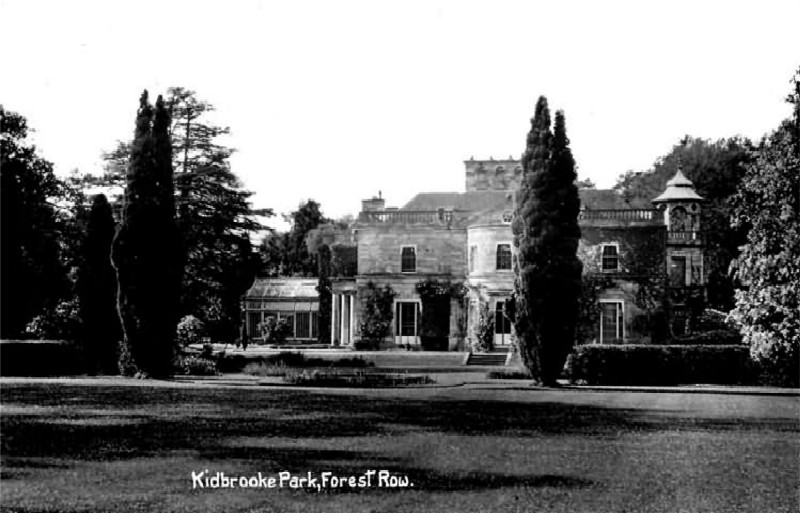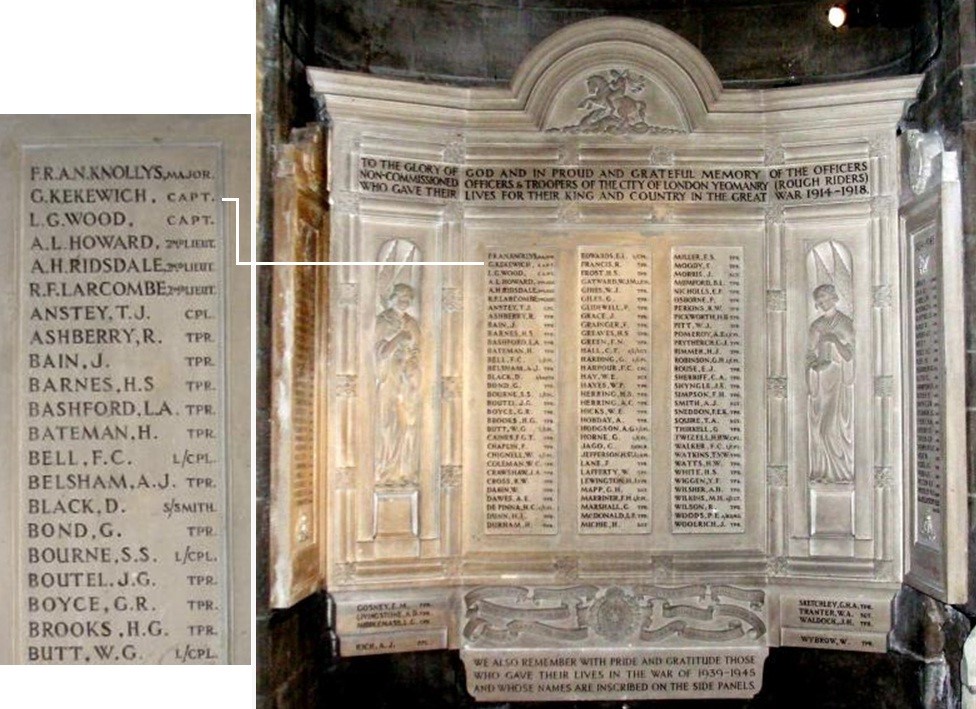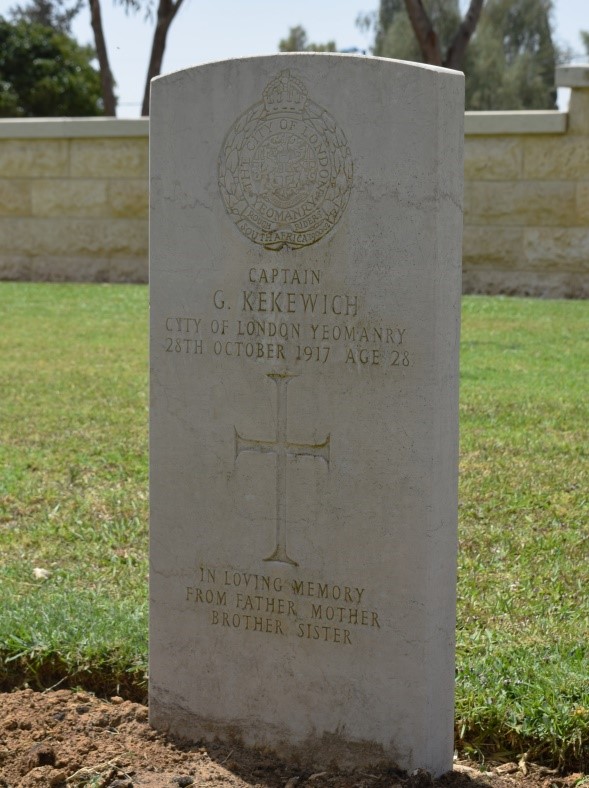GEORGE KEKEWICH
Captain, City of London Yeomanry (Rough Riders), Attd 103rd Machine Gun Corps
Died of Wounds, Beersheba, Palestine, 28 October 1917, aged 28
Buried in Beersheba Military Cemetery, Plot O, Grave 27

Captain George Kekewich
(Click to enlarge)
The Kekewich family originated in Lancashire, but over the centuries had moved first to Cornwall and then to London. There were links by marriage to another well-known Forest Row family, the Freshfields. Four of the sons of Lewis Pendarves Kekewich and his wife Lilian Emily Hanbury fought in World War I and three of them — including George — died during the conflict.
George was the third-born in the family, preceded by his brother Hanbury and sister Evelyn. He was born at Foots Cray in Kent on 20 July 1890, the Forest Row Memorial Book says at the family home, Twisdens, although, according to Byford, he was born at Lamorby Park, in Sidcup. Given that his mother gave the memorial book information, I am inclined to believe the former. His father also appears on the electoral role at 82 Ebury Street, St. George, Hanover Square until 1889, so clearly the family had more than one residence. Lewis was a metal broker in a company called Morrison, Kekewich and Co, and the 1891 census shows George in a household wealthy enough to have five live-in staff. When George was still an infant, his father gave evidence in a fraud trial at the Old Bailey:
I live at Foots Cray; I am one of the executors under the will of George B. Ellicombe ... I had to sign cheques as one of the executors — neither of these cheques were signed by me or by my authority — the imitation of my signature is good, but it would not deceive me...
The fraudster was found guilty.
Shortly after this, the family may have gone abroad, possibly to Argentina; a lady named Kekewich with a 7 year old male child, who would have been the right age to be George, appear on an incoming passenger list from Buenos Aires in 1896. George was sent away to school, and he is recorded aged 11 at Winkfield in Berkshire in 1901 as a pupil at Larnbrook, a prep school run by Edward Ransfield. Fom 1908, he was educated at Eton, where he was in the same house as his brothers, namely Broadbent. Ten years later, of the family, only Hanbury and George were at home at Kidbrooke Park on census night, although there were 11 staff. Both brothers were recorded as metal merchants.

Kidbrooke Park — home of the Kekewich family from 1909-1916
(Click to enlarge)
During his time living in Forest Row, George served as scoutmaster to the newly formed troop of boy scouts in the village. Forest Row Church Magazine referred to him as 'the indefatigable scout master'. He apparently took 16 of the troop to the King's Review at Windsor in 1911 and took the boys camping on Ashdown Forest and Birling Gap. When he relinquished the role of scout master he became the troop's treasurer instead.
At the outbreak of war, George joined the City of London Yeomanry, nicknamed The Rough Riders, a Territorial Army force which was part of the Household Cavalry and Cavalry of the Line. In April 1915 his regiment embarked from Avonmouth on the Scotian, arriving off Cape Helles between 23-24 April and steaming on to Alexandria where they arrived on 3 May. By August they had been moved to Suez where they were on patrol duty until August. After that they were moved to the Dardanelles, and George, a 2nd Lieutenant, was placed with the reserve at Chocolate Hill. These were called into action after a disastrous attack on the Turks at Scimitar Hill resulted in a loss of around a third of the men involved. The weather was atrocious and illness had also decimated the ranks. In October, George ordered an attack of grenades on the Turkish lines, but it produced little positive result.
However, their action under appalling conditions meant that George, along with other officers, was commended for his work.
In November 1915, George's regiment rested in Salonika before being moved back to Egypt to join the London Mounted Brigade. By March 1916, George's regiment was patrolling the railway in the Sinai Peninsula, dangerous work compounded by the effects of extreme heat, lack of fresh water and food, and illness. On 28 May the City of London Yeomanry marched to El Kubri, on the west bank of the Suez Canal, still on railway patrol and still subject to attack by the Turks. He was mentioned in despatches in July 1916. In an action on 3 August, George's horse, and others, stampeded while the soldiers were dismounted and he was forced to double up behind his commanding officer in order to get away. Later in the month he was promoted to Staff Captain, followed by a short period of leave.
Once again, George and his regiment went briefly to Salonika, sailing on 12 November 1916 but returning to Palestine the following summer. They were involved in numerous skirmishes there, and after a rest period between 18-24 October, they were moved up to El Buggar and George's D company was ordered to protect the outpost line which was under attack. There was little cover during their advance over open ground and George and several others were wounded. Despite this, their objective was successful, and they were strongly congratulated by Higher Command. Unfortunately, his wounds proved fatal and George died in Palestine on 28 October 1917. When he was buried at Shellal, according to Byford:
...every available officer in the regiment and a part of 'D' squadron attended the funeral

Memorial at St. Bartholomew's
(Click to enlarge)
The Exeter and Plymouth Gazette reported his demise as 'killed in action' and noted his:
gallant stand when a line of cavalry posts thrown out in advance of our main position was attacked by a much more numerous force of Turks. General Allenby reports that, though outnumbered and enveloped on both flanks, detachments of London Yeomanry fought with great gallantry, holding their position for six hours until assistance arrived, and thereby rendering a great service to their infantry colleagues. The enemy, who numbered 3,000, with twelve guns, made repeated charges with their cavalry, but only succeeded in securing a slight gain of ground at the expense of heavy losses. The British casualties were under one hundred.
The Western Times more accurately states that he died of wounds rather than in action. Either way, it was a second blow for the family, as his brother John had been missing since 1915. The article also noted the Kekewich boys' relationship to their uncle, the late General Kekewich, defender of Kimberley, and to Trehawke H Kekewich of Peamore House in Exminster.

George Kekewich's headstone at Beersheba
(Click to enlarge)
George Kekewich was buried at Beersheba War Cemetery in Palestine, but is remembered in a number of places. In London, he appears on the memorial of the Priory Church of St Bartholomew the Great in Smithfield. Possibly this is because the church is not far from his place of business in Gracechurch Street. A war tablet which included his name (and that of several other Kekewiches) was unveiled in 1920 at St. Martin's church, Exminster. It was inscribed:
Remember the following who gave their lives for God and their country in the Great War 1914-1919.
In addition, along with brothers Hanbury and John, he is remembered on the Exminster Victory Hall Roll of Honour and a simple stone cross erected outside the family home at Peamore in Devon.
Kekewich memorial cross at Peamore (left), Roll of Honour—Victory Hall, Exminster (right)
(Click to enlarge)
As a member of the MCC, George also appears on the Lord's Cricket Ground Roll of Honour, as well as on the Eton College War Memorial and the Hove Library WWI memorial. Finally, as the family lived at Kidbrooke Park for some time, he is also commemorated on the Forest Row War Memorial.
The National Probate Calendar records probate granted to his father on 26 November 1917, with effects of £10,241 7s 3d.

Army Register of Soldiers' Effects
(Click to enlarge)
Pam Griffiths
6 June 2017
Updated 15 September 2019



